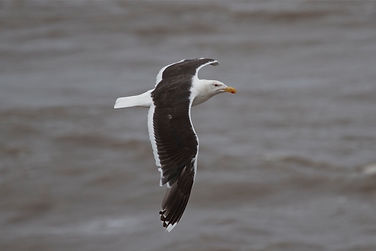
Gulls
Love 'em or hate 'em, you can't ignore 'em. Whilst not one of my favourite groups I do admire them. Accurately identifying them can be a real headache though. The large gulls can take 4-5 years to mature. Juveniles can be really challenging to ID. Each year they subtly change in appearance, until they reach adulthood. To add to that they also change

Three similar species L-R; Lesser Black-backed, Yellow-legged and Herring Gulls. Note the slightly different shades of grey.
between Summer and Winter. People who truly know gulls are real specialists. A flock of gulls, especially in Winter, can comprise several species. You have to look quite hard to see what's there.
Black-headed Gull - Our most numerous inland gulls. Common and widespread. Small to medium sized and resident. Out of the breeding season they aren't black headed at all. Photo 1shows one in Winter plumage.




With chick.
Common Gull - Not that difficult to find in Winter but not as common as the name suggests. They're medium sized and more attractive, in my view, than the big gulls. They're easily overlooked in a crowd of gulls as they tend to be few in number at any one site. Look for a gull that's midway between the herring gulls and the black-headed gulls, with a greenish bill and legs.They tend to be gentler natured too than the other widespread gulls.
Photo 1 shows a bird in Summer breeding plumage on Shetland. The others are Winter birds at various coastal locations.




Greater Black-backed Gull - This is a big bruiser of a gull. Quite stunning when in top, breeding condition. They're aggressive bullies though and will attack and eat pretty well anything, within their range, which can be pretty big. They can be quite numerous, especially around fishing boats.



Herring Gull - This is the species most people think of as the troublesome 'seagull' at our seaside resorts. They will steal you're fish and chips given half a chance. They have that familiar call we associate with being by the seaside. The population is gradually declining though and has been for many years. Love them or loathe them, the seaside wouldn't be the same without them.






Top left is a summer bird and top right a bird in winter plumage, when they develop grey spotting over their heads. The birds immediately above are left a 1st year juvenile and right a bird developing into adult plumage, probably in it's 3rd year.
Kittiwake - A very attractive, comparatively gentle, smallish gull. A true 'sea' gull. They nest on sheer sea cliffs (except for the odd human site like the Tyne Bridge), in large colonies. Usually sharing the cliffs with guillemots & razorbills. They're distinctive with their large dark eyes, yellow bill and black legs.







All taken between June and Sept. Photo 1 and 7 were taken at Scarborough, 2, 3 & 5 - RSPB Bempton Cliffs, Yorks, 4 - A juvenile bird at Dunbar Harbour, Scotland and 6 - Bridlington Harbour.
Lesser Black-backed Gull - Very similar in size and temperament to the Herring Gull. Easily distinguished though with it's much darker grey back and yellow legs. Can be confused with the Greater Black-backed, but they have truly black backs and pink legs, as well as being larger.




Top left is a bird in breeding plumage in May. Top right is in Winter plumage - note the grey streaks on the head.
Little Gull - These are little cuties. Much smaller and more peaceful than their raucous cousins. They only visit spring and autumr, stopping off on their migration. They have totally black heads in Summer.




All taken at Hornsea Mere, Yorkshire in September. A traditional stopping-off point.
Mediterranean Gull - This gull was a rarity in Britain but is gradually becoming more common. Medium size, just bigger than the Black-headed. They have a distinctive jet black head in Summer, as opposed to the dark brown of the Black-headed Gull. Also a chunkier bright red bill. Can easily be missed amongst flock of the aforementioned, but once you have your eye in they do stand out quite well.
Photos 1&4 taken at WBC Belvide. 2 taken at Worcs WT Upton Warren. 3. Sinah Warren. 3&4 show a fully adult bird in May/Jun.




Yellow-legged Gull - Very similar to our Herring Gull the Yellow-legged can be distinguished by their yellow legs (would you believe) when adult, slightly darker grey backs and bright, clean white heads in Winter. They used to be thought of as a race of Herring Gull but are now recognised in their own right as a species. Fairly rare in this country, but seem to be increasing.


I have a confession to make - the first bird was taken in Moraira, Spain. Simply because I've never got close to an adult in the UK. The 2nd (juvenile) was seen off the Scilly Isles in Aug.
Caspian Gull - I have put this one last because it is thought to be a sub-species of the Herring Gull. Although it does have a number of distinguishing features eg longer legs and neck, smaller dark eye, longer bill, sloped forehead and paler legs. Though uncommon we do get a few here every winter. Usually seen at tip sites, lakes and reservoirs or on the coast.

Almost mature bird taken at Attenborough Nature Reserve. 2022.